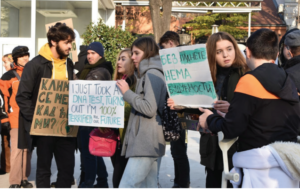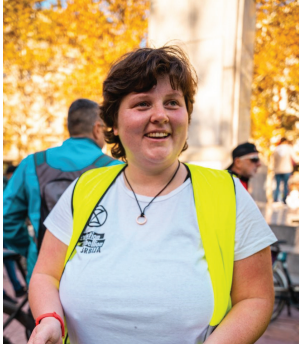Milica Damnjannović Zantvort is an environment protection activist from Serbia. She is a member of “Marš sa Drine” (March over the Drina River) movement, and also
a founding member of the Serbian branch of “Extinction rebellion”, a global movement in which we use non-violent direct action to persuade governments and decision
makers to act on climate and environmental global emergency. Previously she founded the Serbian branch of the international youth led climate movement “Fridays for
Future”. She is also very active in the media and in teaching about the environment.
How does one become an activist?
Activism has many shapes, forms and origins. We all do it for different reasons, but I want to share my journey, to show that activism does not have to start on purpose. However, once it happens, it can change your life and bring you hope.
Already in high school, (I went to agriculture high school), I was fully aware of the consequences of the climate crisis. Although when I was a teenager, the change that will happen “30 years, 60 years or 100 years” from now, as the scientists predicted, seemed like some distant dystopian future.
The fact that those changes are happening already means that the scientists were wrong about the timeline, and that the human-caused climate change is happening faster than they thought. Or that their truth was silenced to begin with.
The year I started high school was one of the driest years on record in Serbia. As part of my homework, I had to research the consequences of drought on agriculture.
I remember reading bits and pieces of the IPCC report in 2007 in my, back then, limited English.
Although I was researching information about Serbia, it was data on Africa that got me really shocked and intrigued. The IPCC report from that year showed how fast the climate crisis is happening in Eastern Africa, and stated that that part of the continent was not ready for upcoming droughts.
This was in 2007.
The following years only got worse. For example, now, more than 10 years later, Somalia is facing 5 years of rainy seasons with hardly any rain.
This does not affect the Balkans though… Does it?
Does it not?
Climate change knows no borders.
It was then in my teenage years that the questions seemed too difficult, the answers too complicated and naturally I decided to do – nothing.
Instead, I became a landscape architect, basically a gardener, and decided not to get myself into the difficult topic of climate change any more than I have to. I never wanted to have anything to do with activism, because it’s too exposing, too social and I did not believe in people’s power to unite.

That was until
2019, and the big international climate protests.
I appreciated Greta Thumberg’s work, her courage, and the attention around her. But it was not exactly her school strikes that led me to want to do something about the topic I have been avoiding for too long.
It was thousands of young people marching into the streets and getting their voices heard, finally fighting for their future.
I wanted to support the young people in Serbia, so I waited for someone to organise a climate strike here.
Anyone.
I would often visit FridaysForFuture global map page, and slowly countries on the Balkans started turning from passive grey to “join the local event” green.
Croatia joined the movement. Albania joined. Montenegro had a protest scheduled. North Macedonia joined. There was a group of young people in Kosovo that had scheduled their local protest. But Serbia remained in this central grey area of passiveness.
It was then that I decided that since no one is doing it, I will make the climate protest myself. First step was to call my neighbour (who was cleaning the windows and organising the protest seemed like a better option). We studied the laws on public gatherings, made a Facebook event on my personal page and called the police to announce a peaceful protest.
The police were the first ones to ask one complicated question: how many people will be there?
So I did the maths – it would be my mom, my neighbour, me and my dog Oski (only because he is on the leash, otherwise I could not count on him either). So three and a half.
I was never more happy to be wrong.
How young people can surprise us.
When the day of the climate protest came, instead of three and a half, nearly 100 people showed up. 100 young people that I did not know, which is far more than I expected.
After the event, they asked me when the next protest would be? I did not plan the second one, but now I felt I had to.
Then, a high school girl approached me and asked if the next time she can bring her whole school, and then if she can join in organising the protests with me. My idea the whole time was to open up the space for the young people to protest, and having an even younger person as an organiser in the movement was such a good incentive for me to continue.
On the next protest, we had even more people, and the protest after that, we had 400 young people marching in the streets of Belgrade, demanding Climate justice.
And then the Covid came.

Covid – young people, the environment and constant switching between digital and real world
Suddenly, the mood changed, the energy we had on the streets moved into the digital world, and there it seemed to have gotten lost. We were not ready for this, of course. No one was. This change hit us hard. We were a self-organised group that barely knew each other, with no resources. Suddenly, the contrast of the protests with hundreds of people (and growing) to a few organisers in online space seemed too harsh, too demotivating.
We needed to change our tactics.
So we used creativity instead of numbers and collective experience to change as a group. That is when we founded the Extinction rebellion in Serbia, and moved from the digital world back into the real world. Even with few people, we could still organise. So we did performances and civil disobedience, with up to four people (groups of over 5 people were forbidden), while still supporting each other and meeting in online space with groups from other towns, from the region and the rest of the world.
A year later, as the lockdown was becoming part of the past, our bond was stronger, but so were the challenges.
In late 2020 and early 2021, it became clear that our government was selling our fertile, agricultural land to turn it into a mining colony.
In 2021, things got real.
Joining local and global movements – why cooperation is important.
As our small but determined group, we did a thorough research on the topic of lithium and other mines that started to get visible thanks to several brave professors and activists.
It became clear that whether it’s Rio Tinto, an Australian-British company or Chinese companies like Zijin, the principle was the same. These multimillionaire corporations are coming to destroy biodiversity, destroy agriculture, poison freshwater and with it help the corrupt governments and other destructive companies into greenwashing capitalism and call it “green transition”. All for the sake of electrical cars and saving car industries, while extracting resources for other industries that would bring them even more profit.
The most obvious destructive new mine was supposed to be in the western Serbia, where the locals are still fighting today. I was there from the beginning, three years ago, when several organisations, movements and individuals started insisting on uniting people regardless of our differences.
The meetings were messy, loud and sometimes organising seemed impossible. But our collective will to protect the land from permanent destruction, the nature that keeps us alive, the soil that feeds us and our will to survive kept us pushing. That is how the movement Marš sa Drine was created, out of pure need for surviving together.
With the Extinction rebellion, we didn’t need a big role in the local movement. However, we saw the opportunity to inform other activists all over the world what was happening. To connect globally and let our fellow activists know about more than one hundred thousand people that are blocking the bridges in the capital and main roads in more than 50 towns all across Serbia. To have them recognize the importance of anti-extractivism, and that we can not exchange one form of destruction with another.
We used our international movement to show that our people are fighting back the corrupt government and the multimillionaire corporations.
It was months of protests of all sizes in different locations that led to an impossible outcome. For a moment, our battle was successful, and the mining project was paused.
Marš sa Drine worked. Our pushback worked.
And only months later, after the elections, Rio Tinto and the government continued pushing again for the lithium mines. As if they wanted our success to be a Pyrrhic victory.
The time we bought while pausing the mine was used well, to strengthen the international bonds, to sign the declaration between organisations from different countries, to regroup and grow more. To plant the seeds for one more year of growing crops.
But we could not be fooled. Even though the prime minister and the president claimed the opposite, the companies are still there. The villagers in Levač are still camping on the roads, not allowing mining companies to drill agricultural lands for research. The city of Novi Sad is being threatened to lose one of the last nature areas, Rio Tinto is still working, Starica mountain in eastern Serbia is still being blown up by the Chinese company Zijing and the government is still selling off land. The fight has to go on.
So how to find the strength to move forward?
In the fight against the mines in the past two years, it is the group of young people that I met in pre-Covid times that are giving me the strength to continue. They continue to be the true inspiration.
But also, every boy at the protest with a whistle, holding their parent’s hands, every girl in the nature area, standing in front of trucks full of construction site waste, every student staying up late to make wonderful artistic signs for the protests, every young woman ready to flip her fingers when surrounded by the police, they are the ones that I learn from about perseverance.
True, working with the younger people can be tricky sometimes, generations that are younger than mine are almost never optimistic, usually demotivated and often seem apathetic behind their screens. But they teach me a lot about determination, pushing through personal boundaries and using those exact screens that we judge them for – for environmental revolution.
Although sometimes it seems like most of the young people are not interested in fighting for the environment, in my personal experience, those that are, are worth hundreds of people. And they are the ones that I don’t doubt for a second that will change the world for the better. They are the ones that I will never give up the fight for.
So see you on the streets, wherever you are.




